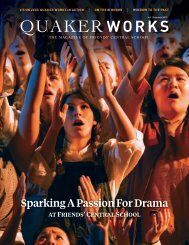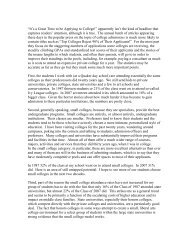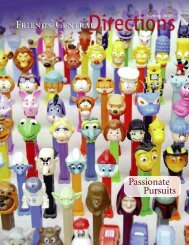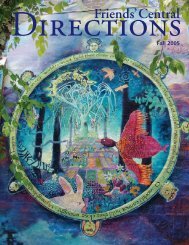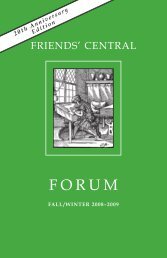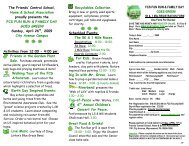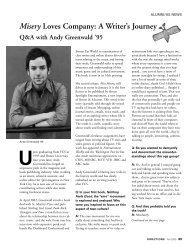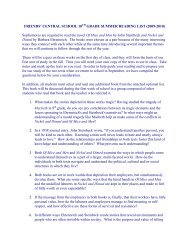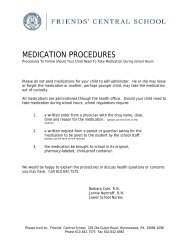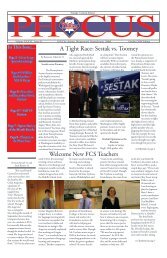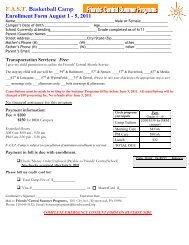2006-2007 Fall/Winter Directions - Friends' Central School
2006-2007 Fall/Winter Directions - Friends' Central School
2006-2007 Fall/Winter Directions - Friends' Central School
You also want an ePaper? Increase the reach of your titles
YUMPU automatically turns print PDFs into web optimized ePapers that Google loves.
out of their immediate environment and asking them to rethink<br />
almost every aspect of how they’ve learned to live their lives.<br />
Take for example our meal plan. We are a vegetarian school.<br />
This decision was made for two reasons. On the one hand,<br />
many of our students come from families in which a healthy<br />
diet is neither a focus nor an economic possibility. Greens and<br />
complex grains just aren’t part of a lot of their dinners. So we<br />
have assumed a responsibility for improving our students’ diets<br />
as well as their minds. But the decision is also an ethical one.<br />
We hope that if the students are required to eat different foods,<br />
they will develop an openness to the world in general.”<br />
The school’s holistic approach is one of the<br />
things that impresses Anne most about the program,<br />
and she firmly supports its sense that it is admitting the<br />
whole family, not just the individual student. After all, she<br />
explains, “We are not saving kids from their situation. We are<br />
empowering families to support their children in their attempts<br />
to improve their lives and opportunities.” In order for it to<br />
accomplish this goal, the school has to encourage the traditions<br />
FEATURES – ALUMNI/AE<br />
and strengths of its students’ neighborhoods and families, even<br />
as it pushes them to seek broader opportunities and experiences.<br />
This delicate dance is most apparent when the students<br />
reach eighth grade and graduate. One third to one half of them<br />
go on to independent schools in the city or boarding schools.<br />
While boarding schools have more funding and a more level<br />
playing field, they also take the kids further away from their<br />
communities and disrupt family life. Day schools, on the other<br />
hand, keep kids at home, but also force them to confront dramatic<br />
socio-economic and social differences on a daily basis.<br />
Whatever path they follow after EHS, Anne believes that her<br />
students’ chances of having a better life depends on their connection<br />
to their families and homes. As she says, “It is all about<br />
coming back and improving the community not just sending<br />
the individual off to participate in a different, better life.” She<br />
may have been born a teacher, but the way she sees education<br />
as a family affair certainly has its roots in her early experience<br />
at Friends’ <strong>Central</strong>.<br />
DIRECTIONS <strong>Fall</strong> <strong>2006</strong> / <strong>Winter</strong> <strong>2007</strong> 43



